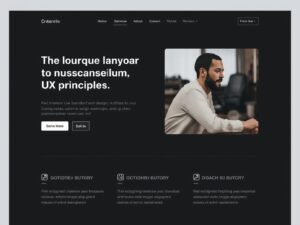When I first started learning about websites, I thought only design and SEO mattered. But with time, I realized something very important — no matter how beautiful your website looks or how many visitors it gets, if people can’t easily use it, they leave fast. That’s where User Experience (UX) comes in.
In this blog, I’ll share from my own experience how good UX can make your website perform better, help you get more visitors, and even grow your business faster.
What Is User Experience (UX)?
User Experience, or simply UX, means how people feel when they use your website.
If your website is simple, easy to use, and helps visitors find what they need — that’s good UX.
But if it’s confusing, slow, or full of errors, people will leave quickly. In short, UX decides whether your visitors stay or go.
From my own work, I’ve seen that even small UX changes — like fixing broken links, improving speed, or making buttons clear — can make a big difference.
Why UX Matters More Than You Think
Most business owners focus only on SEO, ads, or design. But UX is what keeps people coming back.
Here’s why UX matters:
-
It helps users trust your website.
-
It increases the time people spend on your pages.
-
It reduces bounce rate (when users leave after one click).
-
It improves your chances of ranking higher on Google.
When your visitors are happy, Google also notices. Websites with better UX often get better SEO rankings, more conversions, and stronger brand trust.
How Good UX Improves Website Performance
Over the years, I’ve tested many websites. Every time I improved UX, website performance improved too. Here’s how:
1. Faster Loading Speed
No one likes a slow website. If your page takes more than a few seconds to load, visitors leave.
A fast website gives a smooth experience, and people stay longer.
From my experience, a one-second speed improvement can make a big difference in traffic and conversions.
2. Mobile-Friendly Design
Most people in Pakistan browse websites on mobile. If your website doesn’t fit properly on small screens, they’ll leave immediately.
A mobile-friendly site is a must for better UX and SEO performance.
3. Clear Navigation
Good UX means visitors can find what they want easily.
Menus, buttons, and sections should be simple and clear.
When users can move around your site easily, they explore more pages — and that boosts your website’s overall performance.
4. Better Conversion Rate
If your UX is good, visitors understand what you offer and how to take action — whether it’s buying something, filling a form, or calling you.
A confusing layout or unclear button can lose you a customer.
Good UX helps you turn visitors into real buyers.
5. Stronger SEO Rankings
Search engines love websites that people enjoy using.
If users spend more time on your site and visit multiple pages, Google takes it as a positive signal.
That’s why UX and SEO work together — you can’t win one without the other.
Common UX Mistakes You Should Avoid

Even small mistakes can ruin your website’s user experience.
Here are some common ones I’ve seen in Pakistani websites:
-
Too much text or cluttered pages
-
Small fonts and poor color contrast
-
Pop-ups that annoy visitors
-
Confusing buttons or unclear CTAs
-
No contact information or trust signals
-
Poor mobile layout
When you fix these problems, your website automatically feels smoother and more professional.
Simple UX Tips to Improve Your Website
Here are a few easy UX tips you can follow, even if you’re not a designer:
-
Keep your website design clean and simple.
-
Use clear headings and short sentences.
-
Make sure your buttons and links work properly.
-
Add enough white space between elements.
-
Use readable fonts and colors.
-
Test your site on mobile and desktop both.
-
Ask real users for feedback.
When you focus on small details, your website starts performing better step by step.
How I Improved UX on My Own Projects
When I first started working on client websites at i Connect Brandz, many of them looked nice but didn’t perform well.
I tried improving speed, layout, and content flow — and soon noticed real results.
Visitors started staying longer, bounce rate dropped, and inquiries increased.
That’s when I learned: a good-looking website isn’t enough — it must be easy to use.
This simple change helped my clients grow faster, and it can help you too.
Conclusion
Good UX is not just about design — it’s about people.
When you make your website simple, fast, and easy to use, people stay longer, trust your brand more, and take action.
Whether you’re a small business owner, blogger, or student learning SEO, remember this:
A website that feels good to use will always perform better.
FAQs
What does UX mean in simple words?
UX means User Experience, which is how people feel when they use your website — if it’s easy, smooth, and helpful.
How can I improve my website UX?
Start by fixing speed, improving layout, and making your site mobile-friendly. Keep things clear and simple.
Is UX important for SEO?
Yes, Google prefers websites that people enjoy using. Better UX means better engagement and higher SEO ranking.
Do I need a designer for good UX?
Not always. You can improve UX yourself by keeping your site simple, fast, and user-friendly.




